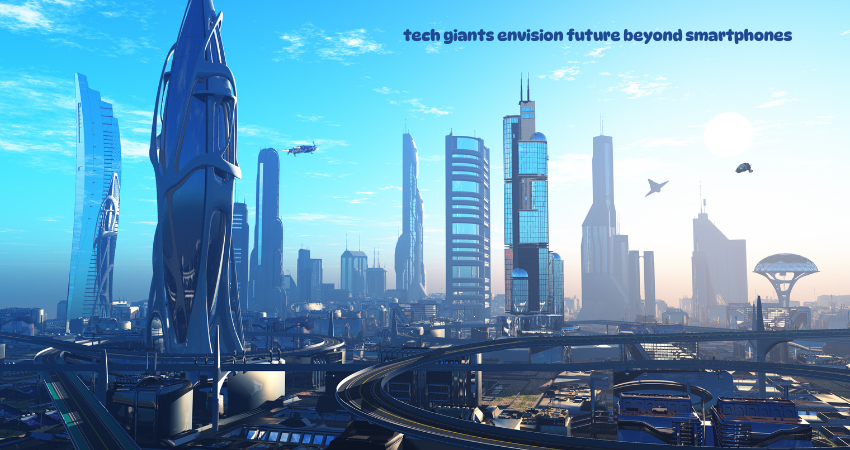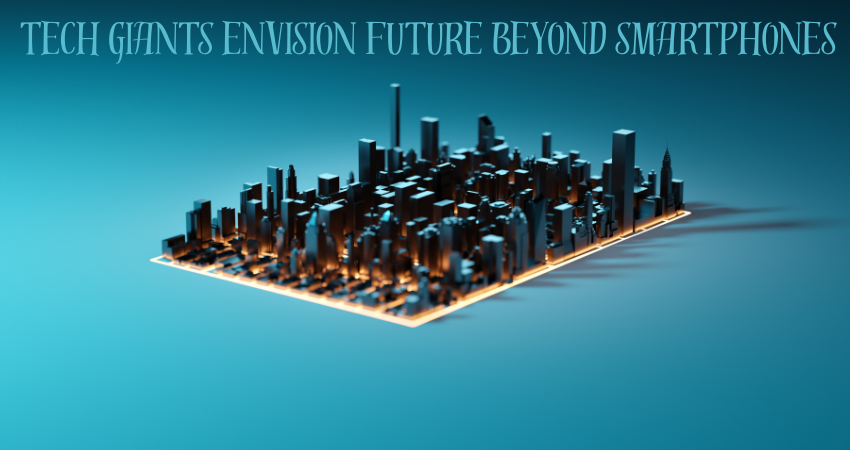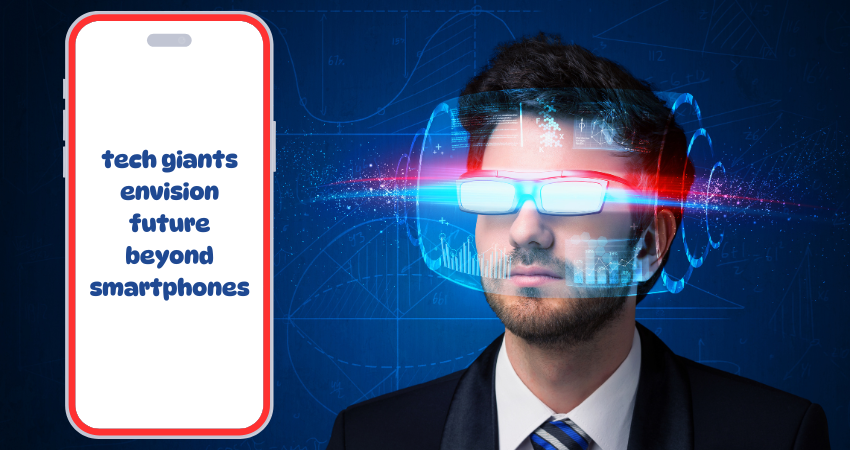Let’s be real—our smartphones are practically glued to our hands. But have you noticed that recent phone upgrades feel… underwhelming? That’s not by accident. We’re nearing the edge of what smartphones can do. And now, the tech giants envision future beyond smartphones—Apple, Google, Meta, and others—are thinking bigger. Way bigger.
What if the next big thing isn’t in your pocket—but on your face, around your wrist, or floating in your room?
The Smartphone Plateau
Tech giants envision future beyond smartphones have hit a wall. You can only make screens so sharp, cameras so smart, and batteries so big. The last few iPhone or Galaxy launches haven’t exactly blown minds. That’s because we’ve squeezed nearly all the juice out of the smartphone lemon.
Plus, users are tired. Who really wants to drop $1,200 every year for slightly better selfies?
Shifting Tech Paradigms
The future isn’t about a better phone—it’s about less phone. Tech is shifting from handheld to hands-free. The goal? Technology that fades into the background and works quietly to improve our lives.
This is where concepts like ambient computing and ubiquitous interfaces come into play. The idea is that tech will just be there—in your home, car, glasses, or even skin—without you needing to look at a screen all day.
Big Tech’s Vision for the Post-Smartphone Era
Apple’s Ecosystem Evolution
Apple is betting big on spatial computing. Its Vision Pro headset isn’t just for VR games. It’s the beginning of an entirely new way to interact with the digital world. Think of it as a screenless computer you wear on your face.
They’re also leaning into wearables—from the Apple Watch’s health features to future AR glasses still in development.
Google’s Ambient Intelligence
Google wants to be everywhere, not just in your phone. With Google Assistant, Nest, and AI-powered search, they’re building an environment that anticipates your needs.
Their Pixel phones are increasingly integrated with AI features that feel more like stepping stones than endpoints.
Microsoft’s Mixed Reality Push
You might not hear much about it, but Microsoft’s HoloLens is quietly revolutionizing industries—from medicine to engineering. And now, with AI Copilot being embedded across their ecosystem, Microsoft is creating an experience where your computer knows what you want before you ask.
Meta’s Metaverse Ambitions
Zuckerberg’s Meta is trying to build an entire world beyond screens. The Quest VR headsets, Horizon Worlds, and Ray-Ban Stories smart glasses are all about merging reality with digital presence. Love it or hate it, they’re setting the stage for how we might socialize or work in the next decade.

Emerging Technologies Leading the Shift
Augmented Reality (AR)
AR lets digital information float in the real world. Imagine walking down the street and seeing restaurant reviews in your vision without picking up your phone. That’s the AR promise.
Virtual Reality (VR)
VR isn’t just for gaming anymore. Virtual workspaces, education, therapy, and even fitness are being reimagined through immersive experiences.
Mixed Reality (MR)
MR merges the best of AR and VR. You can interact with real and digital objects at the same time. Microsoft’s HoloLens is a strong example, used by surgeons and engineers alike.
Wearable Devices
From smart rings that monitor your sleep to glasses that translate languages in real-time, wearables are the new frontier. They’re lighter, more discreet, and offer constant connection without constant distraction.
AI and the Voice-First Interface
Typing and tapping are so 2015. The next era belongs to voice. Tech giants envision future beyond smartphones like Alexa, Siri, and Google Assistant are becoming smarter, more conversational, and context-aware.
Imagine walking into your home and saying, “Let’s start movie night,” and your AI dims the lights, queues up Netflix, and orders popcorn from your favorite store. No phone needed.
Spatial Computing
This might be the buzzword of the decade. Spatial computing refers to tech that understands the 3D world and lets you interact with it naturally—using gestures, gaze, or even your thoughts. Apple’s Vision Pro is a giant leap in this direction.
Neural Interfaces and Brain-Computer Tech
It sounds sci-fi, but it’s real. Neuralink, Elon Musk’s brain interface startup, is developing implants that let you control computers with your mind.
Meta is working on neural wristbands that detect electrical signals from your brain to your hand—letting you “think-click” your way through digital tasks.
The Role of IoT in a Post-Smartphone World
With Internet of Things (IoT), your fridge, car, and coffee maker are all connected. In the future, your devices will talk to each other, not you. Your home will know when to warm up, your car will plan routes, and your appliances will reorder supplies—automatically.
Privacy and Ethical Concerns
Of course, there’s a dark side. As we embed more tech in our lives (and bodies), privacy becomes even harder to protect. Who owns your brain data? Can your AR glasses record others without consent?
The next era of tech must balance innovation with ethics and transparency.
Potential Roadblocks
Not everyone is ready to strap a computer to their face. Adoption will take time. Cost, comfort, and social acceptance are major hurdles. Remember how weird Bluetooth earpieces looked at first?
Affordability and accessibility will decide how fast this transition happens.
A New User Experience
The future isn’t about screens—it’s about presence. Interfaces will “disappear” into the background. You’ll swipe the air, nod your head, or just think about what you want to do. It’s not about less tech. It’s about more natural tech.

The Future of Communication
Imagine talking to a holographic version of your friend halfway across the world. Or collaborating with your team in a virtual room with real-time avatars.
Phone calls and text messages may soon feel as outdated as fax machines.
Conclusion
Tech giants envision future beyond smartphonesthe world, but their reign is slowly ending. What comes next is a tapestry of devices, interfaces, and experiences that dissolve the boundaries between physical and digital life.
Tech giants aren’t just building new gadgets—they’re reshaping the way we live, work, and connect. The question isn’t whether this change is coming. It’s whether we’re ready to embrace it.
FAQs
1. What technology will replace smartphones?
A combination of AR glasses, wearables, AI assistants, and spatial computing is expected to replace many smartphone functions.
2. When will smartphones become obsolete?
Smartphones won’t vanish overnight, but within the next 10–15 years, they may become just one of many connected tools we use daily.
3. How will communication evolve without phones?
Through voice assistants, holograms, mixed reality avatars, and neural interfaces enabling thought-based input.
4. Are smart glasses ready for mainstream use?
Not quite yet. Early versions exist, but mass adoption will depend on comfort, cost, and social norms.
5. Is this future good or bad for privacy?
It’s both. Tech becomes more helpful, but also more invasive. Stronger privacy laws and ethical design will be critical.

